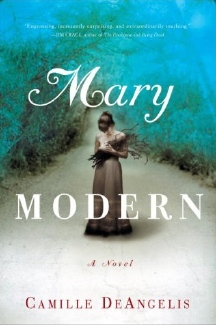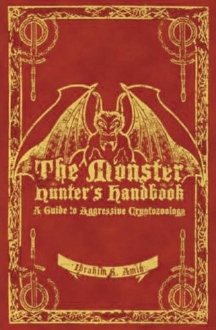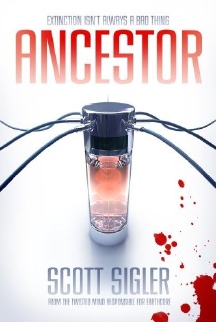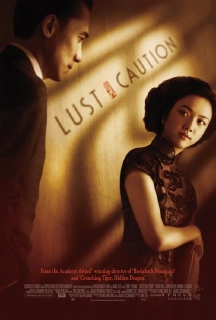|
|
|
|
This Just In...News
From The Agony Column
|
| |
|
07-14-07: Preview for Podcast of Monday, July 16, 2007 : Where no lexicographer has gone before.
Here's an MP3
preview of the Monday July 16, 2007 podcast for The Agony Column.
Enjoy!
|
| |
|
07-13-07: Scott Sigler Unleashes 'Ancestor'
|
Re-Inventing the Family Tree
|
|
Monsters.
LOTS of monsters.
|
Yesterday, I wrote about 'Mary Modern', a gothic tale of genetic experimentation
that results in the re-creation of someone's ... grandmother. It's
a beautifully written novel and a nice update on the gothic genre.
But that's what you'd expect from a girl. Let's a get a guy to take
on this genetic experimentation gig. Do, that, you and you're lucky
to get
'Ancestor' (Dragon Moon Press ; April 1, 2007 ; $19.95) by Scott
Sigler,
a rip-roaring bloodbath chock full o' monsters. Need I say more? I
suppose
I can,
since there are some pretty interesting aspects of this novel beyond
the monsters
deal.
First off, let's note that the premise of this book is straight out
of a non-fiction work covered
here a couple of years ago, 'The Xeno Chronicles'
by one-time horror auteur G. Wayne Miller. That book discussed the
efforts to create pigs that could help facilitate what is called "xenotransplantation",
that is, puttin' a pig liver in an aging but wealthy alcoholic's body.
In Sigler's novel, the competition to create this technology is fierce,
and we get some pretty action-packed pages with government agents putting
a stop to some xenotransplantation gone very wrong. You see, the deal,
you start creating chimera-pigs with some human genetic material, the
fear is that diseases from the pigs will shift a bit and could rip
through the
human population unstopped. This is a bad thing, and in 'Ancestor'
we know this because before you've made your way very far into the
novel, you've
encountered enough bloody corpses to satisfy a small town full of zombies.
So the genius in 'Ancestor', a pouty, dreamy Chinese brilliantine who has
far too many bad dreams to be reliable, she cooks up this idea that you
simply genengineer the ancestor of humans and all mammals. That way, no
diseases and complete compatibility. It's like going back to DOS 2.0 to
create an anti-viral agent for Windows what-the-hell-ever it is now. It
makes some sense, and in any event, sense soon gets thrown out the window
when these ancestors actually show and prove to be a) large and b) hungry.
Mayhem ensues.
Lots of mayhem, the sort of fun monster-action that is often missing in
monster novels. I mean look; you can sort of understand why monster movies
are so frugal about showing you the monsters. They cost money to make and
they tend to look fake unless you've got a lot of money and some real talent.
But in a novel, there's no excuse, and this one needs no excuse. The monsters
are on display fairly early, and you get to see them in variety of disgusting
monster antics. Sigler has a peculiarly fervid imagination when it comes
to gore, so expect lots of inventive bloodiness combined with pretty much
non-stop action. Everybody is always in a hurry in this novel and look
what it gets them. Eaten. Or at least torn to bloody pieces.
So there you have it. Girls bring back grandma, and have her face some
serious, soul-searching dilemmas. Guys, well, they bring back summat you've
never seen before and have it eat the character's faces. And all in the
name of genetic experimentation. Good thing all this science is so dodgy,
none of this is too likely to happen. No we can expect something different
and if experience is any teacher, probably much worse.
|
| |
|
07-12-07: Camille DeAngelis Makes 'Mary Modern'
|
The Gentle Goth
 |
|
| Not
so throroughly modern Mary. |
Science fiction is as chameleonic as an other artform. One writer might
take the theme of gene splicing technology and turn out a toe-tapping
monsterama. Another writer might take the same theme and spin a story
in which she meets her own grandmother. In 'Mary Modern' (Shaye Areheart
/ Random House ; July 10, 2007 ; $24), Camille DeAngelis takes the
second path with felicitous results, assuming you're up for a tale
that combines
sentiment and science. This is not ever easy to pull off, but DeAngelis
has the kind of prose skills to create a day-after-tomorrow story
that is full of the sort of details that draw you in and immerse you
in an
emotional world. This is the kind of novel that reminds you that
indeed you live in an emotional world, a world colored, for good or
for ill,
by your own feelings.
The premise is straightforward if somewhat on the puh-puh-posterous side
of speculative fiction. Lucy Morrigan is a young scientist with a lab in
the basement of her running-down but still vital Queen Anne house on a
tree-lined street in H. P. Lovecraft's Massachusetts. It's the same house
inhabited by her grandmother some 80 years earlier. Lucy finds she can't
get pregnant, at least not by any normal means. So, like any good mad woman
scientist, she decides to clone her dead grandmother. This proves to be
something of a problem, as the genetic material she has comes from a 22-year
old woman. The birth is not the baby she expects. Of course, nothing is
as she expects.
Soft science fiction, as this kind of novel used to be called, lives
or dies by the prose. 'Mary Modern' lives by virtue of DeAngelis' skill
in
creating the world of 1929 and the world of 2009 as seen through the
eyes of a woman. On a sentence-by-sentence, word-by-word level, this
is a gorgeously
executed novel. Step back a bit and the structure is equally intricate
and well-wrought, cutting back and forth between then and now and then-as-now.
DeAngelis is delight to read, and it quickly becomes apparent that
we're reading not science fiction, per se, but rather a gentle gothic.
Gothic fiction has all sorts of associations and tropes, but one of the
strongest is that of the single, smart but vulnerable woman trapped in
a remote setting. 'Jane Eyre' and 'Withering Heights' are probably the
height of this, but Sheridan Le Fanu's 'Carmilla', arguably the first vampire
tale is also key.
All of these influences come to bear in 'Mary Modern' but in a rather
peculiarly science-fiction manner. For the title character, Mary, Lucy's
grandmother
re-created in the twenty-first century is a woman trapped in a baroque,
bizarre setting from which she can never escape. She's been brought
to life beyond the time of her death and is trapped in a future from
which
there is no escape to the person she never was. This is a classic gothic
tale with a nicely wrought modern premise.
Here's where DeQAngelis deserves lots of credit. Even though she plays
fast and loose with the science, she's smart enough to know Clarke's laws,
at least the one that proclaims that a scientist who says something is
impossible is almost always wrong. She uses this bit of uncertainty to
create a situation in which a woman, an authentic soul, has been created
by another woman. But the created soul is based on a woman whose experiences
will forever be unknown to the newly-created version. DeAngelis takes this
concept a lot farther than the reader might expect, using her skills as
a writer to create a gothic, science fiction vision of the present. Imagine,
she asks, if you could meet your grandmother when she was your age. What
might you say? More importantly, what might you feel?
|
| |
|
07-11-07: Eileen Chang Examines 'Lust, Caution'
|
Decision and Being
|
|
The
scanner is in Aptos, the book here in Victorville. And
the cover is ARC – text only. So here is a movie poster
downloaded using an excruciatingly slow dial-up connection.
Variety - as if!
|
We all have a history, a family story that haunts us. For me, the story
is set in Shanghai, during the Second World War. My father's father and
mother were traders; my grandmother had a beautiful house built with
huge bay windows and an expansive, open plan. Of course, this was not
to last. When Japan invaded China, and Shanghai, my grandparents, along
with my father and his sister, were imprisoned in a camp just down the
road from the one immortalized in J. G. Ballard's 'Empire of the Sun'.
(My father found the book a bit florid, actually.) Eventually they were
freed and started their lives anew in the United States. But the family
has retained bits and pieces of that life in China; furniture, paintings,
some robes. Pieces of a story.
It's not surprising then, that when I see a novel or a work that addresses
that particular time and place, I find myself more immersed than usual.
More moved than usual. Stories merge and blur. That was why Neal Stephenson's
'Cryptonomicon' was such an iconic novel for me. Where else would I read
of systems administrators in Santa Cruz (my occupation for many years)
and skullduggery in wartime Shanghai?
When 'Lust, Caution' (Anchor Books / Random House ; August 28, 2007 ; $9.00)
by Eileen Chang showed up in the mail, I was immediately taken by the slim
volume. I read the story in one sitting, at my parents' house in Victorville.
From a hundred year-old trunk in the garage, I unearthed the photos of
my grandparents' house in Shanghai; a photo of them sitting on the Great
Wall. When China opened up in the 1980's, mny father returned to Shanghai
and found the house he had lived in; when he tried to photograph the house,
Chinese police plucked the camera from his hands, removed the film and
exposed it. He was told the house was not the headquarters for the secret
police and there would be no photographs permitted.
All of this played out as a backdrop to the story told by the celebrated
Chang (Zhang Ailing). Born in Shanghai in 1920, Chang studied literature
in Hong Kong, but returned to Shanghai in 1941 during the Japanese occupation.
She wrote two works, 'Romances' and 'Written on Water', that established
her as a literary writer. She moved to America in 1955 and continued to
write; she kept revising and returning to the story 'Lust, Caution' throughout
her life. The biographic similarities between the author and the character
are fascinating, but one is advised to recall that all writing is an act
of invention. Writers decide to bring a character into being.
'Lust, Caution' is a story of both warmth and cruelty, set during the occupation,
concerning a female student, Wang Chia-chih, who inserts herself into the
life of a man who assassination she will help engineer. It is her decision.
It is his life.
Chang's language, translated by Julia Lowell, who provides a very helpful
introduction, is gorgeously detailed and clinically precise. The details
are physical, the precision, emotional. The cumulative effect of the story
is as a series of small blows to the soul, reverberations of a history
that has never stopped playing itself out. Life during wartime. The seduction
of youth and age. Men of power and women of power. It all seems so simple
and yet it plays out in a manner as complex as life.
You might wonder what would impel Anchor to release a novella-ish short
story as a standalone book, and of course the book answers that question
in the form of a short essay by film director Ang Lee, who has chosen to
adapt the story as for his forthcoming film. Lee's insights into the story
are themselves fascinating and co-screenwriter James Schamus provides a
look at both the character of Wang Chia-chih and the author. Granted, this
is a movie that is likely to be worth your valuable time. But the story
came first. The story existed before it was written. It will continue to
exist long after the lights have dimmed in every theater in the world.
Decide for yourself; read and bring it into being.
|
| |
|
07-10-07: Ibrahim S. Amin Unlocks 'The Monster Hunter's Handbook'
|
HOWTO Kill an Evil Critter
 |
|
| Apparently,
Arkham House has Abdul Alhazared locked into some Elder-Sign
contract. |
Let's presume, you've
got a big backyard – say, several thousand
acres. Were you to live in California, you might well have a problem with
coyotes, or say, rattlesnakes. Or even, if your patch of heaven was big
enough, Hydra. You know, the giant nine-headed snake memorably, or at least
ostensibly, slain by Hercules in about a million movies? Perhaps you have
Roc problem. Out here in the west, we'd call one of them-thar-thangs a
Thunderbird, but it all sorts out to be the same vexatious problem. You
got a huge bird, big enough to carry away a cow, a car, an elephant, and
inclined to do so. You can imagine the dropping problem, right? Well, now
that I mentioned it you can.
If this sounds like a situation you’re likely to encounter, or even
if that's not the case, then let me suggest that you run, don’t walk
to purchase 'The Monster Hunter's Handbook' (Bloomsbury ; September 4,
2007 ; $15.95) by Ibrahim S. Amin. Bloomsbury seem to think that they have
a little gold mine in these goofy guides illustrated by Richard S. Horne,
and for a certain sort of reader this is in fact the case. Here's the formula:
Take weird theme, break it down into discrete little bits, write up those
bits with a gloss of humor and a firm appreciation for the literary background(s)
from whence they emerge, get Horne to do his deal and presto – an
instant bestseller for the pocket protector set. Of which I am a card-carrying,
if not protector wearing, member. And I have the set of white, short-sleeved
shirts with little ink spots blooming underneath the pockets to prove it.
In this case, Amin has made some interesting decisions. An introduction
explains the setup. The first is to divvy up this book into two major
sections. You want monsters, you've got monsters. Lots of 'em, in
a section he titles: "Monsters:
A Guide to Aggressive Cryptozoology". Amin's tongue is firmly
lodged in cheek, so it’s going to be hard for the real cryptozoologists
of the work, like the ever-present Loren
Coleman, so take offense. I hope.
Certainly, this is not the serious work that Coleman and the folks
at the
CFZ (the Centre for Fortean Zoology)
undertake. Well, I suppose it is serious,
but Aggressively so. What you get is an A-Z (well, actually "Basilisk
to Zombie") series of short articles on the sort of monsters
that generally aren't seen as friendly and seem to be likely fodder
for the "sportsman" monster
hunter. Yes, you read that right, the sportsman monster hunter. In
a brief intro to the "Aggressive Cryptozoology" section,
Amin suggests that, "Any fool with a gun can shoot a deer, but
only the greatest of sportsmen will be able to overcome the Hydra." Can't
argue with that logic, can you? Or, "Even if you do not plan
to go searching for a monster, there is no guarantee that a monster
will not searching
for you." He suggests that someone may not know how to kill
a vampire, but come on, really; if you don’t know how to kill
a vampire in this culture, you deserve to be drained. And with this
book added to the canon,
you've got just one less excuse.
The entries on the monsters entertainingly enough written and even contain
some nice information, well-organized. You get a description, an illustration,
a passage on "Killing Methods" (I'd like to see a passage on
methods of capture, just because), and best of all, a bullet-pointed Summary
including, when applicable, Dangers (always applicable), Weaknesses, Souvenirs,
and most interestingly, Selected Sources. This latter bit means you get
some nice literary sources for the critter in question; it's fun to see
how he handles these sometimes conflicting reports.
The selection of monsters chosen is not exhaustive but is nonetheless entertaining.
You get the best of the Greek myths, some movie monsters, horror fiction
tropes and OOPC. (Out of Place Cryptid - Sasquatch, to be precise. Nobody's
supposed to hunt Bigfoot! He's our hairy, smelly friend.) Books such as
this live or die by the humor, and truth to tell, Amin can be pretty funny
in a very un-PC manner. Check out his entry on the joys of hunting zombies
in packs ("...a team of hunters can select their favorite weapons
and spend all day massacring in a variety of inventive ways.") Sort
of puts a whole new spin on the zombie movie massacre genre, doesn't it?
But wait, there's more here. The most original part of this book
is the second part, "Enchanted Steel: A Guide to Cryptohoplology".
The "killing
methods" in the first portion of the book generally presume
that one has access only to ordinary weapons, and offers instruction
accordingly.
The second part of the book is a compendium of all the magic armor
and armaments you'd really want were you not to enter stage right,
wearing
a red shirt for your hunting garb. You get a similar format; illo
by Mr. Horne, history and description, then "Combative Applications",
ie: HOWTO kill a monster with it. Here's where Amin gets his humor
out, and he's actually pretty funny. Of course, for folks such as
me, the Selected
Sources listing is the best part of all, beyond the scope of the
weapons listed here. It's impressive, and goes well beyond Greek
myth. I can imagine
that several readers out there will eventually get a story out of
the weapon descriptions in this book.
Everyone else just gets a good time, perfect for nightstand or coffee table
stacking if you have the sort of house that has a coffee table stacked
with literature. Now, it will say something about you as a person to have
'The Monster Hunter's Handbook' on your coffee table. If nothing else,
it means that there are not likely to be any monsters in the vicinity,
so in that case, it provides a sort of welcoming feel. Assuming you aren't
a monster yourself.
|
| |
|
07-09-07: A 2007 Conversation with John Burdett
|
"The idea
of original sin seems sick, morbid, depressing and calculated to
cause psychosis in the people who hold to that view."
|
|
John
Burdett relaxes at KQED.
|
Nothing is more refreshing than a writer who can casually demolish your
carefully constructed worldview while giving you as a reader a rockin'
good-time story that combines horror, mystery and suspense. In this case,
that writer would be John Burdett, who latest novel is 'Bangkok
Haunts'.
He managed to make himself leave his new home in Thailand to promote
his latest novel, and I had the opportunity to speak with him at length
about his most supernatural work yet.
As he's lived in Thailand, Burdett told me, he's become more and more
of a Buddhist himself, which no doubt explains why the voice of his Buddhist
cop Sonchai Jitpleecheep rings so true. Sonchai is easily one of my favorite
first-person cops ever; he's funny and his worldview is so causally alien
that it really makes the fantastic seem like an everyday part of the
reader's world. Or at least, fantastic reading.
You can hear the conversation in MP3 or RealAudio format,
but I'd recommend buying, if not reading, the book first. I've prefaced
the interview with
two readings from the novel, which will give you an idea of Burdett's
wonderfully transparent style, and probably draw you into his world without
original sin. Just prepared for some straightforward talk about subjects
that may make you feel a tad uncomfortable. And prepare to fall into
the culture of guilt or the culture of shame. Or both. Embrace the contradictions – lest
they devour your soul.
|
| |
|
|




